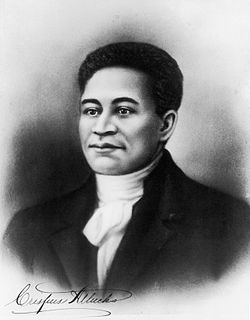Crispus Attucks
| Crispus Attucks | |
|---|---|

Speculative portrait of Attucks
|
|
| Born |
Crispus Attucks c.1723 Framingham, Massachusetts, British America |
| Died | March 5, 1770 (age 47) Boston, Massachusetts, British America |
| Occupation | dock worker |
Crispus Attucks (c.1723—March 5, 1770) was the first person killed in the Boston massacre, in Boston, Massachusetts, and is widely considered to be the first American casualty in the American Revolutionary War. Aside from the event of his death, along with Samuel Gray and James Caldwell, little is known for certain about Attucks. He was probably a Native American slave or freeman, merchant seaman and dockworker of Wampanoag and African descent. Circumstantial evidence suggests his father may have been Prince Yonger, an African-born slave and his mother, Nanny Peterattucks, a Natick Native American.
Despite the lack of clarity, Attucks became an icon of the anti-slavery movement in the mid-19th century. He was held up as the first martyr of the American Revolution, while the others killed were largely ignored. In the 1850s, as the abolitionist movement gained momentum in Boston, supporters lauded Attucks as an African American who played a heroic role in the history of the United States.
Historians disagree on whether Crispus Attucks was a free man or an escaped slave, but most agree that he was of Wampanoag and African descent. Two major sources of eyewitness testimony about the Boston Massacre, both published in 1770, did not refer to Attucks as "black" nor as a "Negro"; it appeared that Bostonians of European descent viewed him as being of mixed ethnicity. According to a contemporary account in the Pennsylvania Gazette (Philadelphia), he was a "Mulattoe man, named Crispus Attucks, who was born in Framingham, but lately belonged to New-Providence, and was here in order to go for North Carolina . . ." Because of his mixed heritage, his story is also significant for Native Americans.
...
Wikipedia
